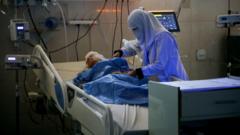Is Gaza's Largest Hospital on the Brink of Disaster Amid Israel's Expanding Offensive?

Understanding the Humanitarian Crisis at Nasser Medical Complex in Gaza
The ongoing conflict in Gaza has escalated to alarming levels, particularly affecting the medical facilities that serve as lifelines for the wounded and vulnerable. Nasser Medical Complex, the largest functioning hospital in Gaza, is currently facing an imminent disaster due to a critical shortage of fuel and an intensifying Israeli ground offensive in Khan Younis. This article aims to shed light on the current situation at Nasser Medical Complex, the humanitarian implications of the conflict, and the broader context surrounding the crisis.
The Current Situation at Nasser Medical Complex
As of recent reports, Nasser Medical Complex has stopped admitting new patients due to the critical shortage of fuel necessary to power its electricity generators. With Israeli military operations intensifying nearby, the hospital's staff and patients are in a precarious situation. Medical personnel have expressed their fears, noting that the hospital is merely meters away from advancing Israeli tanks.
Fuel Shortages and Their Impact on Healthcare
The dwindling fuel supply at Nasser Medical Complex poses severe risks, especially for patients in intensive care and those dependent on ventilators. Medical staff have warned that if the power goes out completely, many patients will face immediate danger and a likely fatal outcome. The hospital has been forced to restrict electricity use to only the most critical departments, which has further strained its capacity to care for patients.
- Critical units affected include:
- Intensive Care Unit (ICU)
- Neonatal Unit
- Emergency Department
Hospital officials have reported that they can only sustain operations for another day under the current circumstances. With the increasing influx of trauma patients due to the ongoing conflict, the situation becomes even more dire.
Trauma Cases on the Rise
According to Dr. Rik Peeperkorn, the Gaza representative of the World Health Organization (WHO), Nasser Medical Complex resembles "one massive trauma ward." The hospital, which typically has a capacity of 350 beds, is currently treating approximately 700 patients. Many of these cases result from violence related to the conflict, particularly during aid distribution attempts.
Examples of Trauma Cases
Among the numerous cases reported, some of the most heartbreaking include:
- A 13-year-old boy who sustained a gunshot wound to the head and is now tetraplegic.
- A 21-year-old man with a bullet lodged in his neck, also resulting in tetraplegia.
These tragic stories highlight the grave consequences of the conflict on young and innocent lives, further emphasizing the urgent need for humanitarian assistance and protection for civilians.
Israeli Military Operations and Their Consequences
The Israeli military has intensified its ground offensive in southern Gaza, particularly in areas surrounding Nasser Medical Complex. Reports indicate that Israeli tanks and troops have advanced dangerously close to the hospital, causing fear among medical staff and patients alike.
Recent Military Actions
Witnesses have reported that Israeli troops, accompanied by tanks and bulldozers, have fired upon nearby camps for displaced families. The use of quadcopter drones adds another layer of danger for civilians attempting to seek refuge or aid. The presence of military operations near the hospital raises significant ethical questions about the protection of medical facilities during armed conflicts.
Evacuation Orders and Civilian Impact
The Israeli military has issued evacuation orders for areas surrounding the hospital, which has forced many families to flee their homes and seek shelter elsewhere. However, with limited resources and the ongoing conflict, many displaced individuals face dire conditions. The humanitarian crisis is compounded by the lack of safe zones and the risk of military engagement wherever they go.
The Humanitarian Response and Challenges
Efforts to provide humanitarian aid and support to Gaza have been severely hampered by the ongoing conflict. While some fuel has entered Gaza, the distribution remains a challenge, with many facilities still unable to access necessary supplies. The World Health Organization and other humanitarian organizations have been vocal about the urgent need for assistance.
Current Humanitarian Needs in Gaza
- Medical Supplies: There is a critical shortage of trauma-related medical supplies, including:
- Bandages and dressings
- Intravenous fluids
- Antibiotics
- Food and Water: Basic necessities such as food and clean water are scarce, leading to increased malnutrition and health risks.
- Psychosocial Support: With so much trauma and loss, providing psychological support for the affected population is essential.
The humanitarian crisis in Gaza is not merely a statistic; it represents the suffering of countless individuals and families who are caught in the crossfire of conflict. The international community must take urgent action to address these needs and facilitate a peaceful resolution to the ongoing violence.
International Reactions and Ceasefire Negotiations
The international community has been closely monitoring the situation in Gaza, with calls for ceasefire negotiations becoming more frequent. Israeli Prime Minister Benjamin Netanyahu has suggested that a new ceasefire and hostage release deal could be just days away, following discussions during his recent trip to the United States.
Sticking Points in Negotiations
Despite optimistic statements from Israeli officials, reports indicate that indirect negotiations in Qatar are currently stalled. Key sticking points include:
- Distribution of humanitarian aid
- Israeli troop withdrawals from Gaza
- Conditions for hostage release
These complexities make it challenging to reach a resolution that satisfies all parties involved, leaving the people of Gaza in a precarious situation.
Conclusion: The Need for Urgent Action
The situation at Nasser Medical Complex is emblematic of the broader humanitarian crisis facing Gaza. As the conflict escalates, the lives of countless individuals hang in the balance, particularly those who rely on medical facilities for life-saving care. The urgent need for humanitarian assistance, safe zones, and a cessation of hostilities cannot be overstated.
As global citizens, we must advocate for the protection of civilians and the provision of humanitarian aid in conflict zones. The situation in Gaza calls for solidarity, compassion, and immediate action to address the suffering of its people.
FAQs About the Crisis in Gaza
What is the current status of Nasser Medical Complex?
Nasser Medical Complex is experiencing a critical fuel shortage, forcing it to stop admitting new patients while medical staff and current patients remain in a precarious situation due to advancing military operations nearby.
How has the conflict impacted healthcare services in Gaza?
The ongoing conflict has led to a surge in trauma cases, overwhelming medical facilities that are already struggling with fuel shortages and a lack of medical supplies.
What humanitarian assistance is currently available in Gaza?
While some humanitarian aid has entered Gaza, including limited fuel supplies, the distribution remains a challenge, and there is a critical need for medical supplies, food, and psychosocial support for the affected population.
The conflict in Gaza is a complex issue that requires urgent attention from the international community. How can we work together to ensure that humanitarian aid reaches those who need it most? #GazaCrisis #HumanitarianAid #NasserHospital
Published: 2025-07-11 12:50:09 | Category: world



